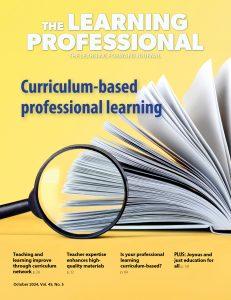The Redesign PD Community of Practice engages teams from 22 of the nation’s leading school districts and charter management organizations in identifying local professional learning challenges and creating scalable solutions. Learning Forward facilitates the community, where teams participate in continuous learning cycles to improve how they manage their professional learning systems.
California’s Long Beach Unified School District, a member of the Redesign PD Community of Practice, uses myPD, a personalized professional growth system in which educators create a professional learning plan, set goals, and find learning opportunities to help them meet those goals. As use of the system increases, district leaders are discovering more about how to deliver professional learning that meets teachers’ needs.
Nathaniel Velasquez, a math teacher at Long Beach Polytechnic High School, wanted to try new opening tasks in his algebra classes. So he logged into myPD, the Long Beach Unified School District’s online learning system, to look for examples and found a teacher demonstrating strategies he could use.
“It was a way for me to see other teachers do something in the convenience of my own home,” Velasquez says. “I didn’t have to schedule an observation. With the video, I thought of ways I could improve.”
Comments such as these are demonstrating to myPD’s developers that teachers understand why the system was created and how it can improve their practice. As one of 22 districts participating in the Redesign PD Community of Practice, facilitated by Learning Forward, Long Beach is also learning lessons that can be useful to other districts working to make professional learning more responsive to teachers’ needs.
“In this age of digital tools and technologies, with instant access to information, teachers would like to have a system that can connect them with resources and support that can help them plan and meet the needs of their students,” says Vanitha Chandrasekhar, Long Beach’s educational technology coordinator. “The feedback we want from our educators is to know what works for them and how we can meet their constantly evolving needs.”
Now in the second year of implementation, the district has trained more than 700 teachers in using the myPD home page and finding self-paced learning opportunities. Almost 600 are using rubrics and self-assessment tools in the system, and nearly 500 are using the system to create a personalized learning plan.
Keeping teachers interested
The district-level team overseeing myPD is using University of Kentucky Professor Thomas Guskey’s five-level framework for measuring the effectiveness of their work. For example, two weeks after teachers are trained on the features of myPD, they complete a survey that asks questions focusing on Level 2, whether they gained knowledge about the system, and Level 3, whether they feel they have the support they need to use what they learned.
User data show that, throughout 2016, teachers logged into myPD almost 48,600 times and that use peaks in October after school has been in session for a few weeks, but also in June as teachers begin thinking about what they would like to work on over the summer.
Nader Twal, a program administrator in the district’s Office of Curriculum, Instruction, and Professional Development, says the numbers suggest that teachers have found the system valuable and are coming back for more.
“We need to increase content that we put into the system at the beginning and end of every semester,” he says. “Keep them interested.”
Measuring impact on students
When the online myPD system was first created, much of the focus was on making sure teachers understood how to access and navigate the system. While that support is still available, the myPD team is increasingly concentrating on making sure the system is helping teachers improve their practice in the classroom.
“We want to let the technology serve the PD and not drive the PD,” Twal says, comparing it to the use of technology in the classroom. “If technology doesn’t serve the kids, it’s a toy, not a tool.”
The team has also begun to use surveys as they work to reach what Guskey identifies as the highest levels of evaluating professional learning: the use of new knowledge and skills and student learning outcomes. Amy Pendray and Jennifer Crockett, program specialists for myPD, wrote about this aspect of their work in the December 2016 issue of JSD. (See “Make evaluation count: To assess impact, know what to measure.”)
“We not only needed to evaluate teacher learning, but also follow up with teachers to see how they were using their new knowledge and skills, and, ultimately, determine how the professional learning impacted students,” they wrote.
To gather that information, they developed a questionnaire targeted to educators who participated in professional learning and had been using their new knowledge and skills for three to nine months. They used the feedback to design additional resources to meet participants’ needs and develop additional content.
Bringing together myPD designers and users
Built into myPD is a rating system that allows teachers to provide immediate feedback on whether the resource or other content they chose was helpful. If the rating is particularly low, the district team is then able to contact the teacher to see why he or she gave that rating. Sometimes the negative ratings have nothing to do with the content of the resource and fall more into the category of a Level 1 barrier — maybe the font was too small on a document or the user couldn’t make out what someone on a video was saying. Those barriers, Twal says, can be addressed easily.
District leaders have also created opportunities for those who design and deliver professional learning opportunities to interact and collaborate with teachers in the classroom. For example, Stacey Benuzzi, a middle school math coach in the district, helped to create the Common Core Demonstration and Development Team. Teachers on the team have been creating videos that are available as self-paced learning opportunities on myPD. So far, they have created about 40 videos for elementary teachers and 40 for secondary school teachers.
“Our teachers always appreciate being able to see Long Beach students in action and learn from their colleagues,” Benuzzi says, adding that she also gets ideas for myPD content from principals, assistant principals, and other teachers who attend face-to-face professional learning.
The role of the Community
Other districts in the Redesign PD Community of Practice have given input and support to the Long Beach team. Ten of the districts from across the country joined Long Beach in focusing on measuring the impact of professional learning as a problem of practice.
“As we have grown in our understanding of this work and developed tools to better measure this impact, our partner districts in the community have provided critical and constructive feedback to refine our work,” Pendray and Crockett wrote in the JSD article.
Ultimately, the district team wants teachers to see that myPD “is about empowering them,” Twal says, adding that teachers can choose whether to share their plans and progress with colleagues and supervisors.
He uses the Uber and Waze mobile apps as a metaphor for how educators interact with the system. With Uber, users are passengers and depend on the drivers to choose the route. MyPD, he says, is more like Waze, in which users receive the information they need to make better decisions on the way to their destination.
“We’re not looking to drive them there,” he says. “We want them to be better drivers.”
This post originally appeared in Learning Forward’s PD Watch.





